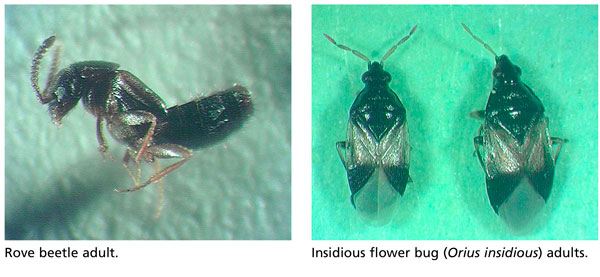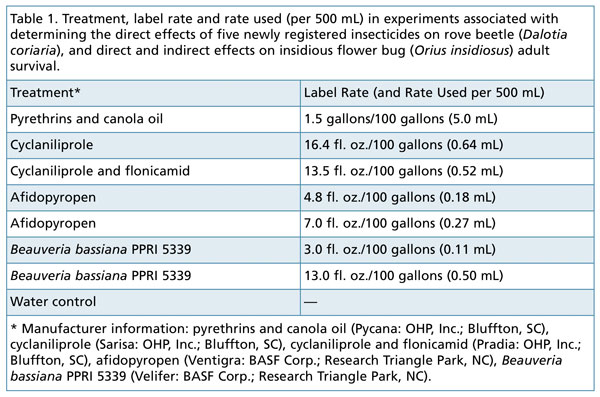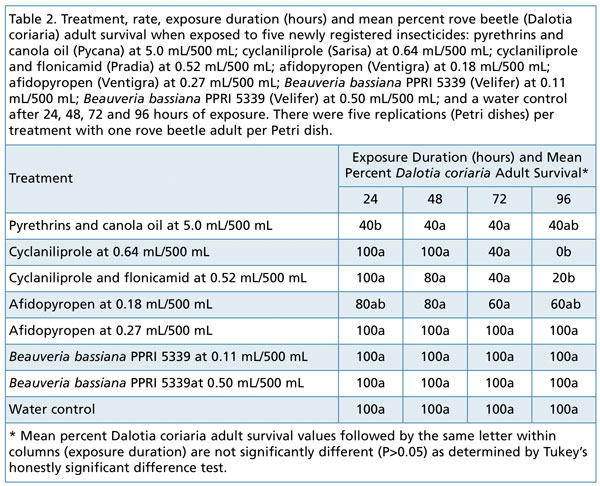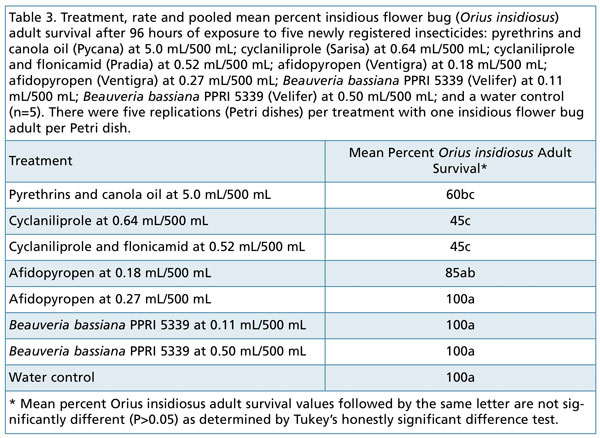6/1/2023
The Effects of Insecticides on Two Beneficial Insects
Nathan J. Herrick & Raymond A. Cloyd

The rove beetle (Dalotia coriaria) and the insidious flower bug (Orius insidiosus) are predators used in greenhouse production systems. Rove beetle larvae and adults feed on fungus gnat (Bradysia spp.) larvae and the pupal stages of western flower thrips (Frankliniella occidentalis) in the growing medium. Insidious flower bug nymphs and adults feed on the larvae and adult stages of western flower thrips on plant leaves and/or in flowers.
In greenhouses, biological control agents may not be effective in managing insect or mite pest populations below plant-damaging levels. Consequently, the application of insecticides or miticides may be required to help provide management of insect and mite pest populations on greenhouse-grown horticultural crops.
However, the direct and indirect effects of insecticides and miticides should be considered to avoid disrupting the ability of biological control agents to manage insect or mite pest populations. Direct effects are related to acute mortality or survival, over a specified time period, of life stages such as the egg, larva, nymph, pupa or adult. Indirect effects involve inhibiting feeding behavior, reducing prey availability, negatively affecting foraging behavior or mobility, or reducing female reproduction.
 The objective of our study was to determine the direct effects of five recently registered insecticides on rove beetle adult survival, as well as the direct and indirect effects of the insecticides on insidious flower bug adult survival, and ability to feed on western flower thrips adults under laboratory conditions.
The objective of our study was to determine the direct effects of five recently registered insecticides on rove beetle adult survival, as well as the direct and indirect effects of the insecticides on insidious flower bug adult survival, and ability to feed on western flower thrips adults under laboratory conditions.
Materials & methods
The study involved two laboratory experiments conducted in the Department of Entomology at Kansas State University.
Experiment 1: Direct effects of insecticides on rove beetle adult survival
The experiment was set up as a completely randomized repeated measures design using glass Petri dishes (100 x 15 mm) lined with 9 cm diameter P8 Fisherbrand filter paper. The treatments included pyrethrins and canola oil (Pycana; OHP, Inc.); cyclaniliprole (Sarisa; OHP, Inc.); cyclaniliprole and flonicamid (Pradia; OHP, Inc.); two rates of afidopyropen (Ventigra; BASF Corp.); two rates of Beauveria bassiana PPRI 5339 (Velifer; BASF Corp.); and a water control. All treatments were prepared in 500 mL of tap water and there were five replications (Petri dishes) per treatment with one rove beetle adult per Petri dish to prevent cannibalism. The number of rove beetle adults used in the experiment was contingent on availability from our laboratory colony. (Treatments and rates are presented in Table 1.)
A sterile, 1.0 mL plastic syringe was used to dispense 1.0 mL of each treatment solution onto the filter paper in the Petri dish to ensure that the solution was evenly distributed over the entire filter paper, which would simulate how the biological control agent would be exposed to insecticide residues on a treated leaf surface. About 0.04 g of moistened oats was provided as a food source for the rove beetle adults in each Petri dish.
Same-aged rove beetle adults were collected from our laboratory colony and transferred into Petri dishes with the treatments using an aspirator and a 33 mL plastic vial. Petri dishes were covered with a lid and a foam disk (9.5 cm diameter) was inserted inside the top portion of the lid to prevent adults from escaping. The Petri dishes were maintained in the laboratory at 75 to 82F (24 to 28C) and constant light for 96 hours. The number of live and dead rove beetle adults was recorded after 24, 48, 72 and 96 hours of exposure to determine the direct effect of the treatments on adult survival.
Experiment 2: Direct and indirect effects of insecticides on insidious flower bug adult survival and feeding behavior
The experiment was set up as a completely randomized repeated measures design using glass Petri dishes (100 x 15 mm) lined with 9 cm diameter P8 Fisherbrand filter paper. The treatments were the same as those described above for the rove beetle experiment.
 Insidious flower bug adults were collected from our laboratory colony and transferred into Petri dishes using an aspirator and a 33 mL plastic vial. Petri dishes were covered with a lid and a foam disk (9.5 cm diameter) was inserted inside the top portion of the lid to prevent any adults from escaping. Petri dishes were maintained in the laboratory at 75 to 82F (24 to 28C) and constant light for 96 hours. All treatments were prepared in 500 mL of tap water and there were five replications (Petri dishes) per treatment with one insidious flower bug adult per Petri dish to prevent cannibalism. The number of insidious flower bug adults used in the experiment was contingent on availability from our laboratory colony.
Insidious flower bug adults were collected from our laboratory colony and transferred into Petri dishes using an aspirator and a 33 mL plastic vial. Petri dishes were covered with a lid and a foam disk (9.5 cm diameter) was inserted inside the top portion of the lid to prevent any adults from escaping. Petri dishes were maintained in the laboratory at 75 to 82F (24 to 28C) and constant light for 96 hours. All treatments were prepared in 500 mL of tap water and there were five replications (Petri dishes) per treatment with one insidious flower bug adult per Petri dish to prevent cannibalism. The number of insidious flower bug adults used in the experiment was contingent on availability from our laboratory colony.
A sterile, 1.0 mL plastic syringe was used to dispense 1.0 mL of each treatment solution onto the filter paper in the Petri dish to ensure that the solution was evenly distributed over the entire filter paper. Like the rove beetle experiment, we wanted to simulate how the biological control agent would be exposed to insecticide residues on a treated leaf surface. (Treatments and rates are presented in Table 1.)
The number of live and dead insidious flower bug adults was recorded after 24, 48, 72 and 96 hours of exposure to assess the direct effect of the treatments on adult survival. Furthermore, after 96 hours, surviving insidious flower bug adults were transferred into fresh Petri dishes containing approximately 20 western flower thrips adults. The insidious flower bug can feed on more than 20 western flower thrips per day. The Petri dishes were sealed with parafilm to prevent any insects from escaping. After 48 hours, the number of western flower thrips adults fed upon was counted to determine if exposure to the treatments affected feeding behavior, which would indicate an indirect effect of exposure to the insecticide treatments.
In both experiments, percent adult survival was determined by dividing the number of live individual adults per treatment by the total number recovered and multiplying by 100. Data were analyzed with treatment as the main effect. Individual treatment means were separated using Tukey’s honestly significant difference test when there was a significant treatment effect.
Results
Experiment 1: There were significant exposure duration (time) (F = 5.04; df = 3, 145; P = 0.0024) and treatment (F = 10.24; df = 7, 145; P<0.0001) effects on rove beetle adult survival. Ninety-six hours of exposure to the treatments significantly reduced rove beetle adult survival (65% survival) compared to 24 and 48 hours of exposure (90% and 88% survival, respectively), but not 72 hours of exposure (73% survival). The pyrethrins and canola oil at 5.0 mL/500 mL, cyclaniliprole at 0.64 mL/500 mL, and cyclaniliprole and flonicamid at 0.52 mL/500 mL treatments significantly reduced rove beetle adult survival (0 to 40% survival; n = 5 rove beetle adults; Table 2). The afidopyropen at 0.18 mL/500 mL treatment resulted in 80% and 60% adult survival. All the remaining treatments resulted in 100% survival of rove beetle adults (Table 2).
 Experiment 2: There was no significant effect (P>0.05) of exposure duration (time) on insidious flower bug adult survival. However, there was a significant treatment effect on insidious flower bug adult survival (F = 15.71; df = 7, 145; P<0.0001; Table 3), so the data were pooled within treatment.
Experiment 2: There was no significant effect (P>0.05) of exposure duration (time) on insidious flower bug adult survival. However, there was a significant treatment effect on insidious flower bug adult survival (F = 15.71; df = 7, 145; P<0.0001; Table 3), so the data were pooled within treatment.
The pyrethrins and canola oil at 5.0 mL/500 mL, cyclaniliprole at 0.64 mL/500 mL, and cyclaniliprole and flonicamid at 0.52 mL/500 mL treatments significantly reduced insidious flower bug adult survival (45% and 60% survival; n = 5 insidious flower bug adults) (Table 3). There were no indirect effects observed regarding feeding on western flower thrips adults by surviving insidious flower bug adults after exposure to any of the treatments, with all western flower thrips adults fed upon within the 48-hour time period.
Discussion
The 0.27 mL/500 mL rate of afidopyropen, as well as the Beauveria bassiana PPRI 5339 rates of 0.11 and 0.50 mL/500 mL, were not directly harmful to rove beetle or insidious flower bug adults with 100% survival after 96 hours of exposure.
Cyclaniliprole, and cyclaniliprole and flonicamid were directly harmful to rove beetle and insidious flower bug adults with <50% survival. Our study is the first to demonstrate the direct effects of the two insecticides on biological control agents. Cyclaniliprole is an anthranlic diamide similar to the insecticide cyantraniliprole (Mainspring; Syngenta Crop Protection), which has been shown to be directly harmful to rove beetle and insidious flower bug adults after 96 hours of exposure (60% and 40% adult survival, respectively) under laboratory conditions.
In conclusion, our results demonstrate that afidopyropen and Beauveria bassiana PPRI 5339 can be integrated into plant protection programs for western flower thrips, which include the rove beetle and insidious flower bug. We found that the insecticides pyrethrins and canola oil, and cyclaniliprole were directly harmful to both biological control agents. However, none of the insecticides tested indirectly affected the ability of the surviving insidious flower bug adults to feed on western flower thrips adults. GT
Raymond A. Cloyd (rcloyd@ksu.edu) is a Professor and Extension Specialist in Horticultural Entomology/Plant Protection and Nathan J. Herrick (nherrick@ksu.edu) is a Research Associate in the Department of Entomology at Kansas State University in Manhattan, Kansas.